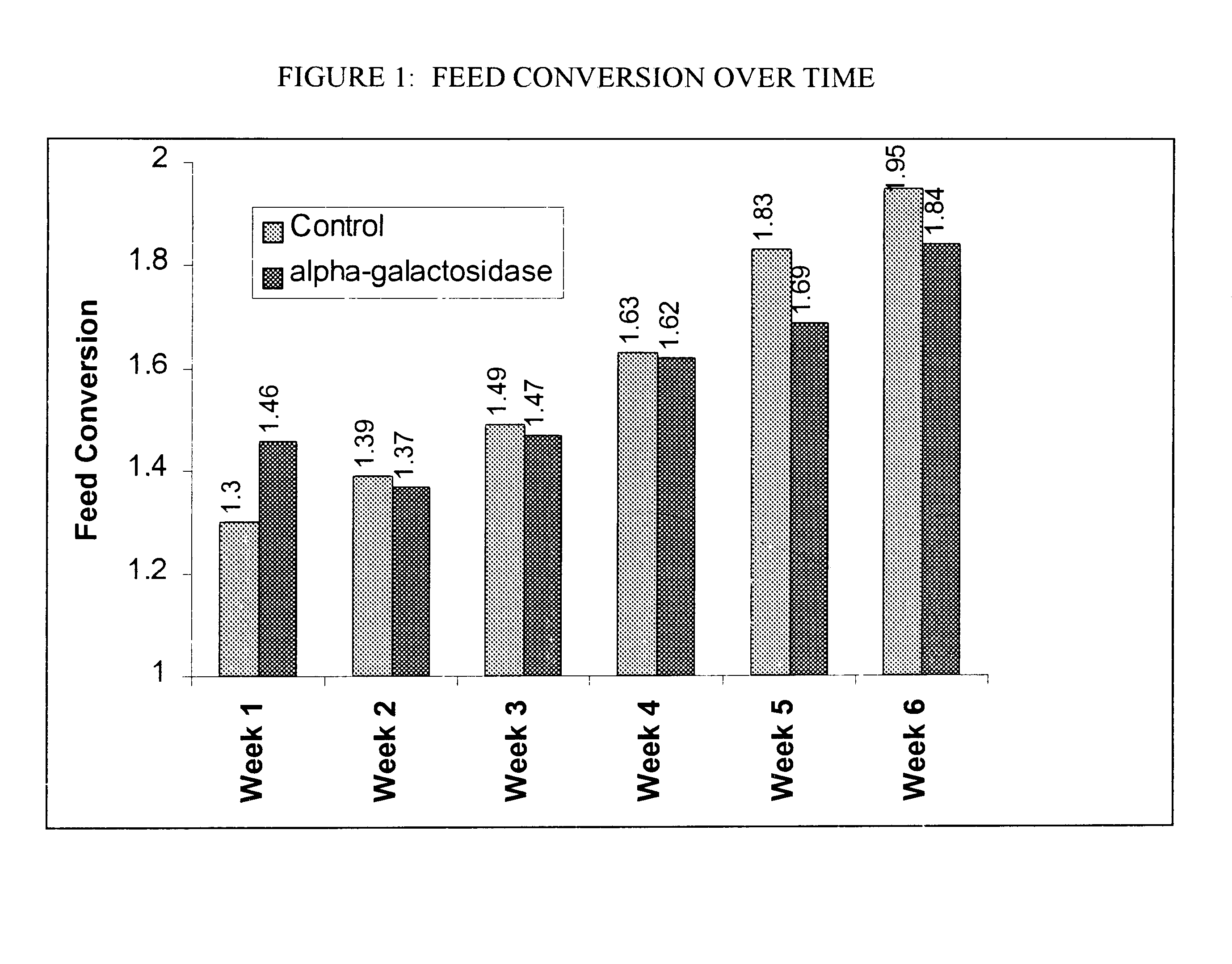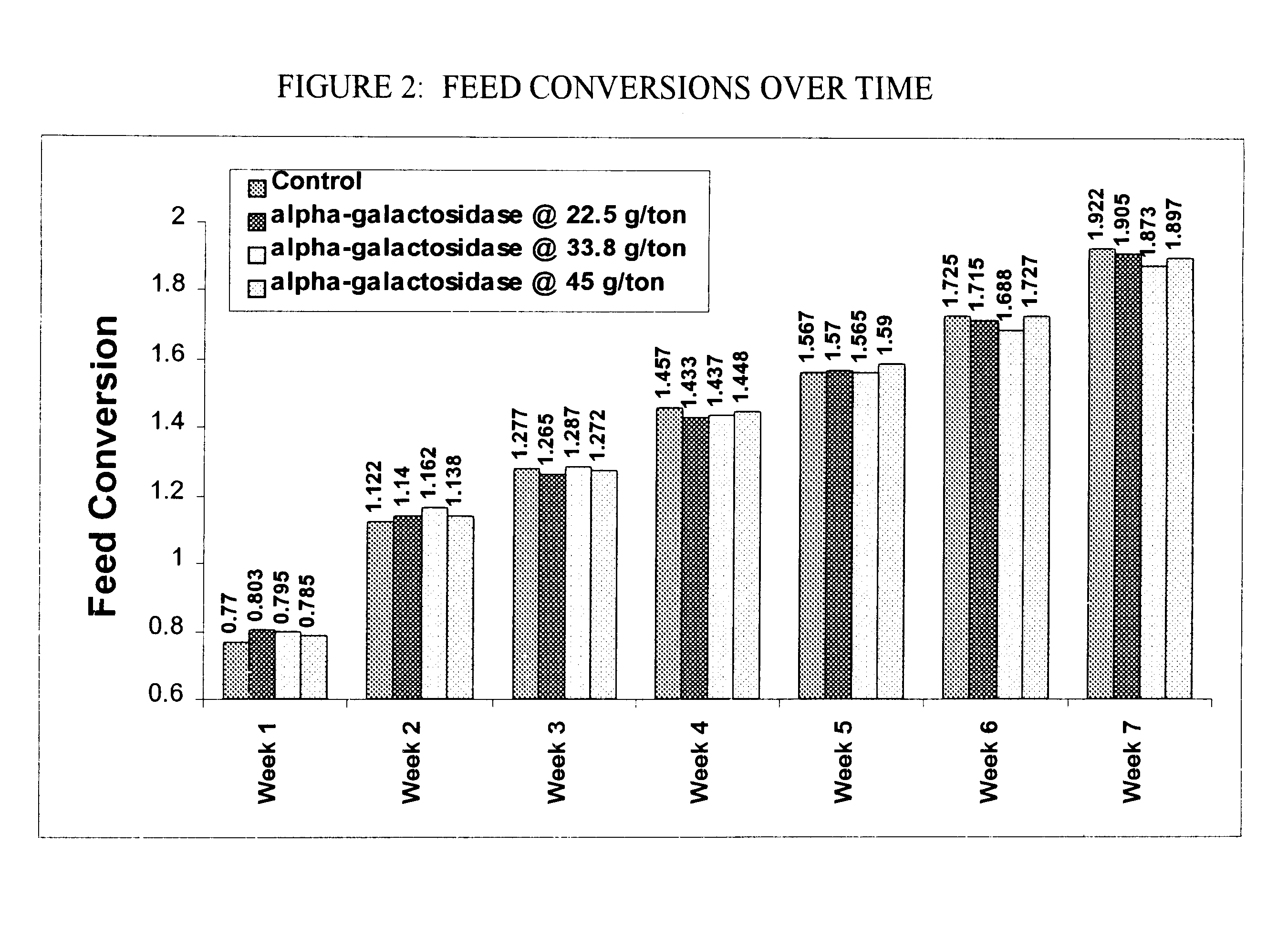Method for increasing breast meat yields in poultry
a technology for poultry and breast meat, applied in the field of methods for increasing the breast meat yield of poultry, can solve the problems of secondary problems, flatus and diarrhea, chickens, and other animals are not able to digest non-starch carbohydrates,
- Summary
- Abstract
- Description
- Claims
- Application Information
AI Technical Summary
Problems solved by technology
Method used
Image
Examples
example 1
Two thousand four hundred straight run Ross x Hubbard HY commercial broiler chicks were randomly distributed among 24 identical pens. A total of 100 chicks (50 males and 50 females) were placed in each pen to provide a 0.75 density. Twelve pens were randomly allocated to either control starter, grower, and finisher basal diets without the enzyme supplement, or basal diets supplemented with an enzyme supplement including 30% .alpha.-galactosidase by weight. The basal diets used contain a nutrient profile which is representative of those used commercially. The nutrient and ingredient composition of the diets are outlined in Table 1.
All of the rations were manufactured in a commercial feed mill, and were produced in the form of crumbles. The enzyme supplement was added by spraying on a mixture of 112 g of enzyme supplement and 888 g of water per ton of feed, resulting in a ration having 34 g of .alpha.-galactosidase per ton or an .alpha.-galactosidase activity level of 23,500 units per...
example 2
Trial 1: The performance of broilers fed an enzyme-supplemented diet was compared to those fed a basal diet over the six-week duration of the trial. Performance was monitored by the measurement of feed conversion, body weight and percent mortality. Four hundred male broiler chicks were randomly assigned to 20 floor pens with 20 birds per pen, thus providing 10 repetitions per treatment. The experimental enzyme product was used at an application rate of 150 g / ton of finished feed. As in Example 1, 112 g of the enzyme concentrate was diluted with potable water to create one liter of a solution that was then sprayed onto the mash feed as it mixed.
A three-feed program was used in which the starter diet was fed for 21 days, the grower from day 21 to 35, and the finisher / withdrawal from day 35 to the conclusion of the trial at 42 days. A coccidiostat (Coban.RTM.-60 brand menosnsin sulfate from Lily) was incorporated into the starter and grower diets at the rate of 0.075%. Feed and water w...
trial 2
was conducted at a poultry research facility to determine performance as measured by feed conversion rates, body weight gain and percent mortality. Nine hundred and sixty Ross x Cobb broilers were randomly placed in 24 pens, with 20 males and 20 females in each pen. The four treatments in this trial consisted of the control diet and the control diet with enzyme supplementation at 75 g / ton, 112.5 g / ton and 150 g / ton. This scheme provided for six repetitions per treatment. As in Trial 1, the enzyme concentrate was diluted with potable water to 1 l and sprayed on the feed as it mixed.
Broiler starter, grower and finisher rations were used in this trial. The starter diet was fed to day 21, the grower from day 21 to 38, and the finisher from day 38 to the conclusion of the trial at 49 days. The diets in this study are those set out in Table 5. The starter ration was fed as a crumble, the grower and finisher as short pellets. Feed and water were provided ad libitum for the duration of the ...
PUM
 Login to View More
Login to View More Abstract
Description
Claims
Application Information
 Login to View More
Login to View More - R&D
- Intellectual Property
- Life Sciences
- Materials
- Tech Scout
- Unparalleled Data Quality
- Higher Quality Content
- 60% Fewer Hallucinations
Browse by: Latest US Patents, China's latest patents, Technical Efficacy Thesaurus, Application Domain, Technology Topic, Popular Technical Reports.
© 2025 PatSnap. All rights reserved.Legal|Privacy policy|Modern Slavery Act Transparency Statement|Sitemap|About US| Contact US: help@patsnap.com


